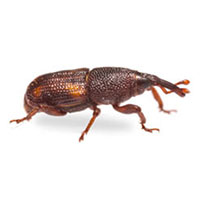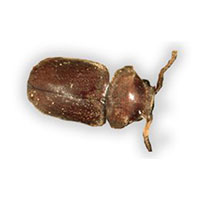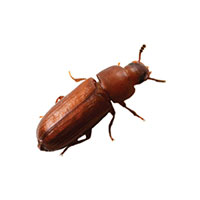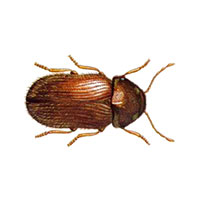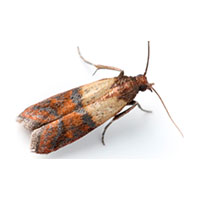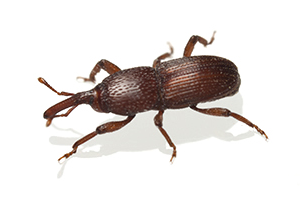
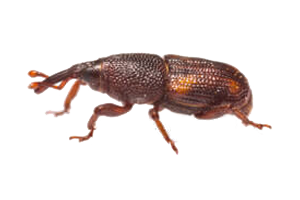
Weevil Diet
Both larvae and adults feed on grain products including rye, barley, buckwheat, beans, stored cotton, cashews, cereals, pasta, and birdseed.
Weevil Habitat
Most of their life is spent within the grain kernel. Emergence holes of the rice weevil are smaller than those of the granary weevil and tend to be smooth and round. There is generally no external evidence that the larvae have been eating and growing inside the seed until after about one month when the adult weevil chews through the seed coat and emerges.
Weevil Life Cycle
The egg, larva, and pupa stages of weevils occur in the grain kernels and are rarely seen. Females drill a tiny hole in the grain kernel, deposit an egg in the cavity, then plug the hole with a gelatinous secretion. The egg hatches into a young larva which bores toward the center of the kernel, feeds, grows, and pupates there. New adults bore emergence holes from the inside, then leave to mate and begin a new generation. Emergence holes of the granary weevil are fairly large and tend to be more ragged than smooth and round.
Rice Weevil
Female rice weevils lay between 300 and 400 eggs, with the life cycle requiring about 32 days for completion. Two larvae can develop in one wheat kernel.
Granary Weevil
The life cycle is about 30 to 40 days during the summer, and 123 to 148 days during the winter, depending on temperature.
Signs of a Weevil Infestation
There is generally no external evidence that the larvae have been eating and growing inside the seed until after about one month when the adult weevil chews through the seed coat and emerges.
Containers
Look in unsealed food containers, where the presence of warm grains near the surface may indicate a rice weevil problem.
Holes in grain bags
Holes in stored grains may also signal an infestation of weevils.
Heat
Ingrain silos, elevators, and other storage facilities, infested grains may feel heated near the surface.
Moisture
Grains may be damp to the point that molds and fungi start to appear.
Kernels
Damaged kernels may also indicate a weevil infestation as does the sight of recently emerging adults.
Flying
Rice weevils are excellent fliers, though they may fall to the ground and feign death when startled.
Light
Finding the pests near a source of light may also denote a possible infestation.
Weevil Damage
Damage is caused primarily by the larvae but also by the adults. In undisturbed environments with the right conditions, rice weevils can almost completely destroy entire elevators or bins of stored grain. Their ability to fly only exacerbates the problems they cause. The pests develop within the grain itself, leaving behind hollowed-out kernels that can no longer be used.
Weevil Prevention & Control
Weevils Prevention
Storage Bins: Keeping storage bins properly sanitized may be the best way to avoid weevils. Removing all old grain and dust before putting in new items can help cut down on potential incursions. Additionally, any spilled grains should be removed immediately.
Cracks: Treat and seal all cracks, crevices, and other points of entry.
Insecticide: Approved insecticides may be used but only when handled by a knowledgeable individual like a trained pest control professional.
Rotate food: Rotate products with consistency using old food items before new ones to help reduce the risk of a weevil infestation.
Weevils Control
- Cupboards or shelves holding infested items should be emptied and thoroughly vacuumed, especially the cracks and corners.
- All products containing or made of whole grains need to be inspected. Discard infested foods in outdoor trash. Infested decorations (flowers, wreaths, etc.) should also be discarded.
- Store all dried food, including dried pet foods and birdseed, in a glass or plastic container with a tight lid. This will contain the infestation if one is present.
- Consume older food products prior to newer purchases of the same food. Products purchased in larger quantities (e.g., from a wholesale food warehouse) are more likely to become an infestation source if these are stored for long periods of time – especially if they are not stored in containers with tight-fitting lids.
As weevils reproduce inside of grains, the cost of trying to eradicate an infestation without professional assistance may end up being as high as the cost of losing the stored product itself.
If a weevil infestation occurs, count on a professional pest management service to take care of the problem knowledgeably and successfully.
Need help with Weevils?
We'll call you! Leave your information below.
Pests Belong Outside!
Leave your information below and we will give you a call back.
"*" indicates required fields
*During normal business hours. After hours inquiries will be returned the next business day.

